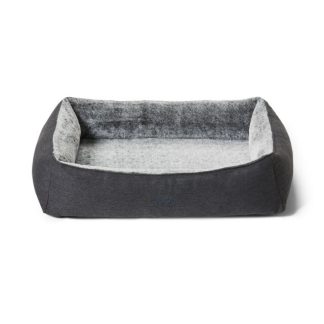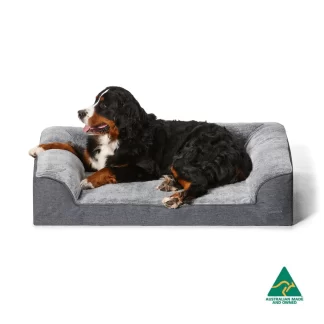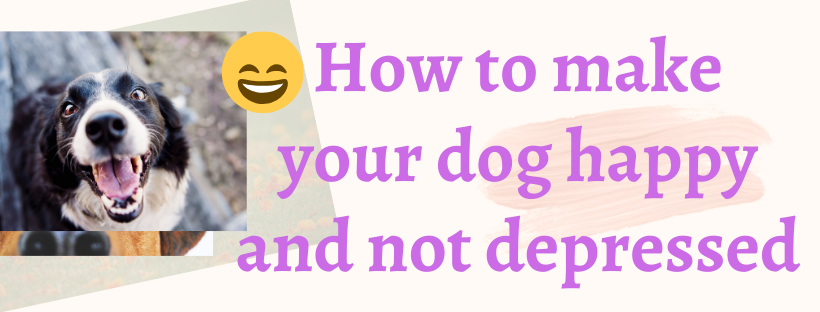
We wrote this article on how to make your dog happy and not depressed as we see a lot in the news and social media about the importance of having a pet dog; in particular for companionship as well as health benefits such as increased feelings of empathy, relaxation, and trust, as well as reduced levels of anxiety and stress.
However, have you ever thought how we humans can also have a positive effect on the lives of our pet dogs? This Blog is designed to capture and share with you the Top 10 ways to make your dog happy.
We have sourced our lists from various, named sources that we have then added our own content to.
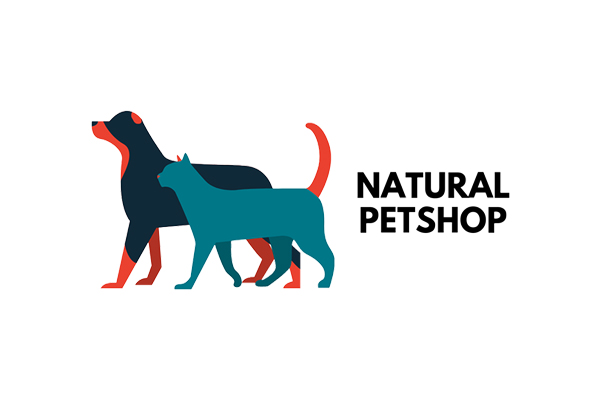
The 10 best ways on how to make your dog happy and not depressed
We sourced this Top 10 List from The Bark; where it was published under the title “Make your dog’s life better” in Nov 2010 (& updated in Aug 2019) and is attributed to Karen B London PhD.
1. Turn up dial on the exercise meter
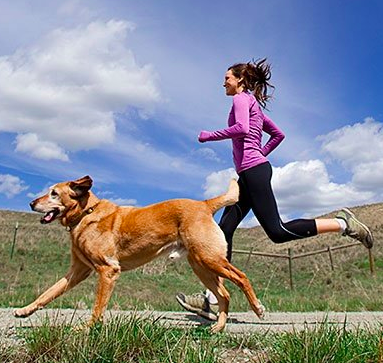
Any dog owner knows how much dogs love activity.
I can remember growing up we only had to say the word “walkies” to our dog and he would be running around in front of us, tail wagging and making all sorts of funny noises.
Most dogs can be pushed and will do so willingly.
If you have somewhere that you could take him for a hike, or log run they will enjoy that a couple of times a week instead of a daily, shorter walk.
Many areas have dog friendly parks, and in some cases a local beach or section of a beach where your dog can run off the leash.
They also usually have Dog Poop Bags at each entry point of the park or beach, so remember to always clean up after your dog and dispose of the bag into the bin.
2. Fight boredom
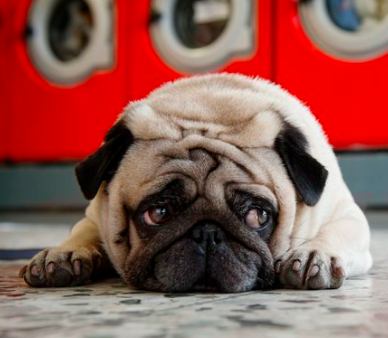
We humans all suffer from boredom on occasions and it is no different for dogs.
Find and use mental exercise tools.
Dogs love activities such as enrichment puzzles, new toys, visits to new places, and learning new skills and tricks.
Examples include:
- Advanced obedience training.
- Teach them new tricks, with a training session each day.
- Do not stick to one route when walking them as it will give them something new to look at.
- Name your dog’s toys and teach them to know their names.
- Get a box for the toys and teach your dog to put them away.
- Create a scavenger hunt in your yard and hide treats inside some of them. We have some great examples that you could use in our previous Blog, “The Top 10 – Homemade Dog Treats Recipes”.
- Try an online dog learning tool such as Dognition.
- The games were developed by scientists, trainers, and behavioral specialists, are fun and easy to play, and are a workout for your dog’s brain.
3. Give them a hand
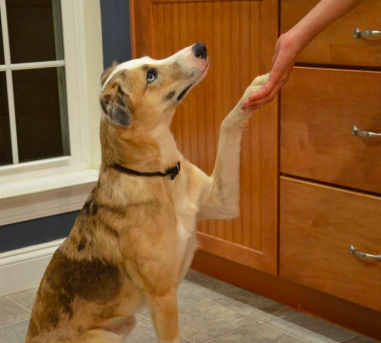
Visual signals are usually learned faster by most dogs than verbal ones.
During training, make sure that you are communicating more clearly by using words at the same time as using hand signals.
You will actually find that your dog will respond quickly and for them it now means you have a common language.
4. Rub them the right way
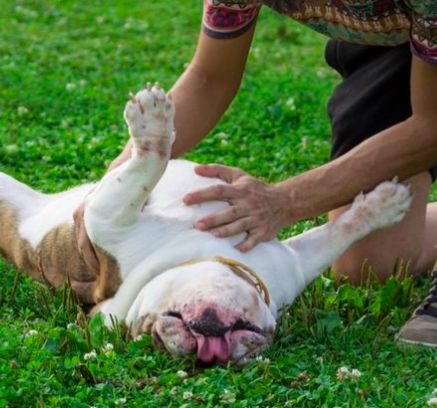
Like most of us humans many dogs love a great massage.
It is a great relaxation tool as well as pro not only promotes relaxation, healing and bonding.
The immune system function can be boosted.
It can reduce their anxiety levels.
Muscle tone can be improved.
Aids in removing toxins and waste products from your dog’s muscles and tissues.
Reduces the risk of injury.
Reduces muscle and joint pain.
Increased blood flow can help with healing.
Flexibility can increase.
5. Stop and smell the world

Hopefully you have read one of our previous Blog Posts; “Your dog is not a baby – A dog should be treated as a dog”.
Dogs need to be dogs, and one of their major past times is following scents.
Using their noses comes naturally, and depending on the breed, their innate sense of smell is between 10,000 and 100,000 times stronger than humans.
Let them use it.
Dogs can detect chemical signals from each other using scent.
The reason that dogs stop and smell the urine and feces of other dogs is because they can detect the pheromones that tell them the age, gender, reproductive status and many other things.
They are collecting information on other dogs around them and how relevant that may be to them.
6. Free them from fashion

We would suggest removing your dog’s collar at night before they go to sleep in their designer dog bed.
Dogs don’t like to feel constrained and enjoy the freedom of being free of clothes etc.
If you dress your dog up you are actually masking their body language and that can have a detrimental effect on their behavior.
Some costumes could be a choking or chewing hazard.
If the costume is ill-fitting your dog could accidentally harm itself if it gets snagged on another object.
7. Feed them well
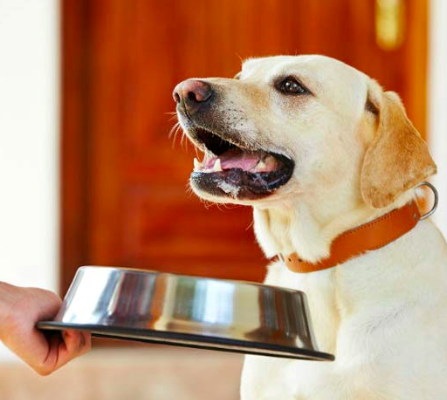
Current public opinion about canine nutrition, is that most people concur that a variety of food, especially if it’s healthy and fresh, has many advantages.
We have actually published two previous Blog posts; “The 10 Best Balanced Homemade Dog Food Recipes” for main meals and “The Top 10 – Homemade Dog Treats Recipes” for those special occasions.
Both recipe collections use a vet approved range of ingredients so that your dog gets a balanced diet.
Homemade always tastes the best, a home cooked meal can teach you more about how to make your dog happy and not depressed.
The reward for the small amount of effort of making your own dog food far outweighs.
No matter what you feed your dog always be conscious of portion size.
8. Keep them tidy
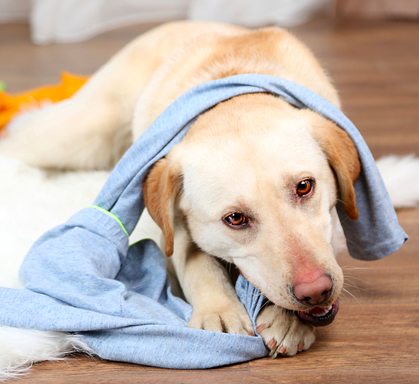
Dogs are always more comfortable when their coat has been well maintained and free from tangles etc.
They love a good brushing and this is a sure way to learn how to make your dog happy and not depressed.
Keeping their toenails short will result in more comfort and easier movement.
Unless you are really confident on being able to clip their nails, we would recommend getting this done professionally.
Many breeds have hair that falls in front of their eyes and therefore they need an occasional trim there for unobstructed vision as a better and safer choice.
9. Play it up

You can start socialization training with your puppy prior to 26 weeks of age.
This is where you get them playing with other puppies of a similar age.
It is an easy and really effective way of building solid socialization behavior.
Your local vet may even have other owners they could connect you with so that you have someone local to meet up with.
A vet may also recommend a supervised play date to start with to help you determine what is appropriate puppy play, and what may be more like as “bullying.”
10. Sharpen your focus
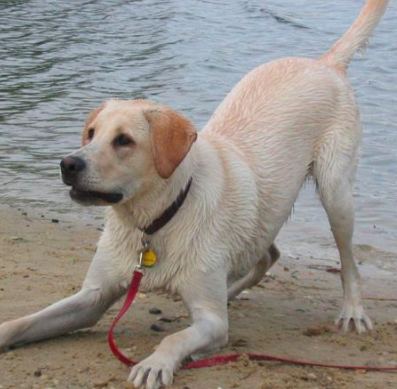
One thing that dog’s value is the special time they get to spend with you.
So that we focus just on them, it may be beneficial to do this without anyone else around.
If you have more than one dog then this special time is even more beneficial and valuable.
Remember that the more you enhance the quality of life for your dog, the more you will also enhance your own.
From our research Karen London was trained in the USA and the latest info we could find it appears that she now resides in Arizona with her family.
What we decided next was to see if we could find some Australia-specific info to see if our different lifestyle was then reflected in how people here interact with their dogs.
How to make your dog happy and not depressed in Australia
Given that our lifestyle, house design and construction, climate, vegetation, native animals in Australia are very different to the USA we decided to research how to make dogs happy in an Australian way.
That initial research turned up a book titled, “Making dogs happy – how to be your dog’s best friend”, by Dr Melissa Starling and Prof Paul McGreevy, and first published in 2018.
What we have then done is take the titles of each of their 10 Chapters and turned that into an Australian-specific list, titled “how to make your dog happy and not depressed”, using edited content from their book along with our own original content.
10 Ways to make an Australian dog happy and not depressed
What makes a dog happy?
Humans and dog’s think differently and place differing levels of importance on things; don’t expect a dog to be able to understand or match and mirror you all the time.
Dogs have an innate sense of smell and you need to be aware that smell will dominate behavior and a dog’s response in many situations.
There are many different races in the human world and the dog world is no different.
There are often dog breed-specific traits and behaviors that you need to be aware of if you have already bought a specific breed or are still considering which breed to buy.
Humans are very much visual animals, but remember that a dog’s eyesight isn’t as strong as ours. They are very sensitive to movement and in many breeds, can see a lot further than us.
Dogs generally have superior hearing to humans, particularly with higher frequencies.
A dog’s skin (and fir) along with sensitivity on their feet can be quite different to ours so bear that in mind when brushing, combing etc. as well as any exercise activities you create for them.
What dogs want
If you watch your dog long enough you will start to see the elements of their behavior that are important to them.
You take it to the next level when you incorporate games, activities etc. that turn into achievable goals for your dog.
Their behavior and happiness will change through every day, based on events going on around them such as proximity of other dogs, if they sense human movement near them, and especially if they detect human’s in the kitchen.
They will also use specific behavior if they sense there is a reward; in particular, a food reward.
You need to be the one driving the reward process; not the dog so you know how to make your dog happy and not depressed.
If you suspect that you dog likes a particular action and it is one of their ways of achieving one of their goals, then start delivering that behavior to them constantly.
That will test that you are reading their behavior as well.
Most dogs respond well to food treats; but remember they are treats rather than an essential part of their diet. You control their consumption, not the dog.
Dogs love fun and will sometimes even choose it over food.
Develop appropriate games and activities that give them pleasure and a workout; physically and mentally.
Dogs love company from other dogs as well as humans.
If you only have the one dog, find neighbors or friends who are in a similar position and meet up regularly so that the dogs can interact and play.
Dogs always like to feel safe; build in reinforcement that reassures them that they are safe.
How do i know what dogs don’t want?
The flip side to dog’s needing to feel safe is that they do not like to feel threatened. This will definitely not produce a happy behavior in them.
Certain breeds suffer with temperature extremes; in particular with heat.
To counter this, make sure you reduce the amount of physical activity during those periods, be mindful to avoid places where they could burn their feet and make sure that there is plenty of water for them to drink.
Dogs do not like to lose control; situations such as if they were guarding a toy from a human or another dog; being picked up to avoid a potential conflict; even when they are having their nails clipped or their coat shampooed.
Crowding can bring a negative response; take care not to get in your dog’s face or bring in your hand directly towards their face.
-
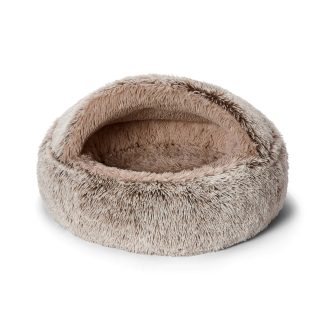 Snooza The Best Hooded Cave Dog Bed, Faux Fur, Machine Washable, Grey$125.99 – $173.99
Snooza The Best Hooded Cave Dog Bed, Faux Fur, Machine Washable, Grey$125.99 – $173.99
How to keep a dog happy when home alone?
Dogs and humans don’t share a common language and therefore we cannot just ask our dog if they are happy.
Instead, we can learn to read their happiness level through; a) their body language, and b) through the choices they make and the activities in which they engage.
A dog’s behavioral state of arousal can be observed;
With high behavioral arousal you will pick up their heart rate being elevated, sweating from between their paws, panting and muscle tension and a narrowing of their focus levels.
With low behavioral arousal they will be calmer, have slower movement and relaxed muscles.
Monitor their tail wagging and height; a high tail is often associated with alertness, and can lead to aggression if with another dog and neither will lower their tail.
A low tail tends to indicate some submissiveness and that they are willing to let someone else take control.
A dog’s face and ears can indicate how they are feeling; so, learn by watching your dog as this can be different in different breeds.
In the mood: how to dogs handle optimism, pessimism and stress?
Dogs have been known to have moods; usually influenced by their perception of risk.
This perception of risk is always assessed with a balance between the risk and them avoiding any potential danger.
While dogs cannot talk to us, we can learn to read their moods by watching their behavior and how the world around them is interpreted.
Just because a dog may be averse to taking risk doesn’t necessarily mean their happiness level is lower.
Personality can come into force here as not every dog responds the same way.
It is a part of life that stress will be experienced by all dogs; just as it does in humans. However, bear in mind that this may manifest into something serious if experienced often over a long period.
Consult your vet for an assessment if this is likely with your pet.
What floats my dog’s boat?
Dog’s don’t arrive on our doorstep with a full arsenal of skills and behaviors; they need to learn them.
That is where we can help them learn new ways of reinforcing things as a positive part of their life through finding the new activities that we have tailored to make them happy.
As a dog owner you will also benefit greatly through watching your dog enjoying life.
When dogs do the things that they love you can see their happiness levels washing over any daily worries or anxieties they may have had.
Most dogs love new objects so coach and repeat them through the process of learning that this new object will add to their life.
How can I be my dog’s best friend?
Dogs will often be confused by words or message that we are saying to them however, they will be able to gauge enough of an understanding of our body language.
They also learn to keep a keen eye on our hands, as the learn that we often talk with our hands through things such as pointing, feeding them treats, handling their bowls, grooming, putting on their collard and leash, picking up the car keys for example.
You can then use your hands to teach them more skills.
It is worth the effort of building trust with them through positive use of your hands.
They will also learn to observe your posture, speed and movement and use this skill to try and reach more goals to their advantage or to please you and gain a reward.
There will also be times where you have to discipline the dog and this needs to be done in ways that you avoid using your positive reinforcers.
You need to use the right reinforcement in the right place and at the right time, this is an important point on how to make your dog happy and not depressed.
Dogs are social acrobats
Most dogs are capable, and enjoy socializing with dogs of many other breeds.
In domestic dogs there is a window of opportunity when the puppy is 3 – 12 weeks of age where they are very open to new information.
Having this healthy level of socialization is important for creating a happy life ahead of them.
It needs to be done in ways that do not frighten or overwhelm them.
This opens them up to develop new communication styles as they develop in life, so remember this when you are thinking about how to make your dog happy and not depressed.
Don’t give up on the shy, frightened puppy as with positive reinforcement and coaching from you there is every likelihood of getting a positive result.
Caring for your dog from puppy to old age
As with humans there is constant development in a dog as it advances from puppy, through adolescence, adulthood and finally to old age.
They need the most attention from us in puppyhood, adolescence and early adulthood.
Puppies in particular need to be close to their family and will naturally see you as the one who looks after and feeds them.
You will spend a lot of time in the early stages with training and the use of reward systems when they respond as intended.
There may be negative behaviors too and something such as leaving the puppy alone may be distressing at first but is a much more powerful tool to use than other more frightening methods.
Adolescence is generally from about 6-months of age through to 12-18 months. Put simply, they can be worse than the human equivalent of the naughty toddler or pre-teen all wrapped up in once.
This is the stage where they will test the limits, even ignore previously taught commands. Keep at it as you may have to walk them on a long leash at times until they come around again to knowing you are the boss.
Eventually maturity arrives and they will once again be more responsive to you and your commands.
Senior dogs tend to be less bold and sociable as they ages. They can also become more stubborn and may ignore commands, particularly if they are curled up or sitting somewhere comfy.
Keep an eye on older dogs for pain; many breeds suffer from Arthritis or have hip displacement issues to name a few. It’s a time in life to make them comfortable and that’s where you may need to upgrade them to a more appropriate style of dog ped.
Have them vet checked periodically to make sure they are still comfortable and that any pain is managed.
-
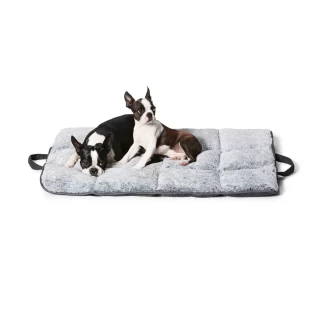 Portable Pet Travel Mat, 66 x 90 cm, Quilted Plush Grey, Foldable with Carry HandlesOriginal price was: $92.99.$83.99Current price is: $83.99.
Portable Pet Travel Mat, 66 x 90 cm, Quilted Plush Grey, Foldable with Carry HandlesOriginal price was: $92.99.$83.99Current price is: $83.99.
How can I choose a dog that will make me happy?
When choosing a dog make sure firstly that it is one that can make eye contact with you.
Do research on breeds if it is a breed that you have to buy.
Every breed has plus and minus points as well as positive and negative health issues to manage through their lifespan, so keep this in mind when thinking how to make your dog happy and not depressed.
Personality, temperament and behavior are important things to look for no matter the breed.
Make sure you can afford a dog.
Do you have the right amount of time in your lifestyle to care for, feed and exercise a dog?
Look for a dog that is trainable. You need to be able to have a dog that will follow commands and who will recognize that you are in charge.
Australian risk factors to avoid
We have seen that things such as games, exercise etc. can all add to a more positive, and happy dog.
Long walks in parks, dog-friendly beaches and even around your own home can put your dog at risk if certain plants or other creatures are present.
These threats could be toxic and lead to your dog becoming very ill or even be fatal.
Back in one of our earlier Blog Posts, “Dog Friendly Backyard Landscaping Ideas” we talked about the care needed around the home and certain plants etc. to be avoided.
However, there are many other things to look out for depending on where you exercise your dog, including:
- Snakes
- Lizards
- Goannas
- Sea snakes
- Blue bottles
- Other poisonous jelly fish
- Puffer fish
- Poisonous snails
- Turtles
- Ticks
- Poisonous plants
- Discarded food
- Fishing hooks
- Broken glass
-
 Snooza Deluxe Car Travel Dog Bed, Waterproof with Reversible Cushion, GreyOriginal price was: $173.00.$157.99Current price is: $157.99.
Snooza Deluxe Car Travel Dog Bed, Waterproof with Reversible Cushion, GreyOriginal price was: $173.00.$157.99Current price is: $157.99.
Summary
A dog is a wonderful addition to any household but it is important to get the right breed, size, age and temperament so that it fits into your lifestyle.
They will bring a tremendous amount of happiness to you and your family and hopefully some of our points in this Blog will help you in ways to bring additional happiness to your dog’s life as well.
- When is dog diarrhea an emergency – The complete guide - October 17, 2022
- What do you do if an off-leash dog approaches you while you are walking a dog? - October 9, 2022
- Mindiampets Birthday Bacon Dog Cookie Crumbles - October 7, 2022

